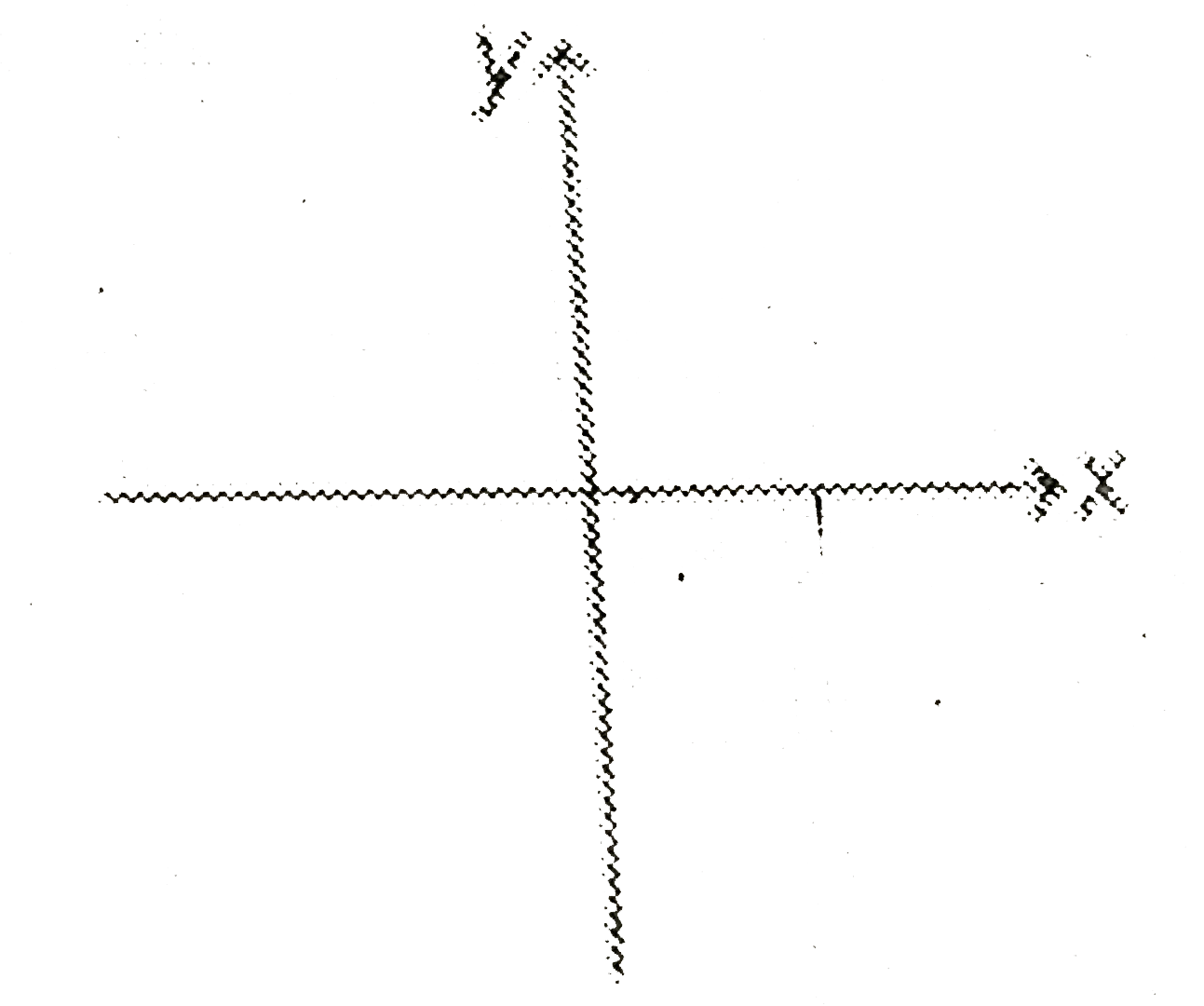Equations y = 2 A cos2ωt and y = A(sinωt+√3cosωt) represent the motion of two particles.
Only one of these is S.H.M
Ratio of maximum speeds is 2 : 1
Ratio of maximum speeds is 1 : 1
Ratio of maximum accelerations is 1:4
The correct Answer is:A
To solve the problem, we need to analyze the two equations given for the motion of the particles and determine which one represents Simple Harmonic Motion (SHM) and calculate the ratios of their maximum speeds and accelerations.
Step 1: Identify the equations
The equations given are:
1. y1=2Acos2(ωt)
2. y2=A(sin(ωt)+√3cos(ωt))
Step 2: Check if the first equation represents SHM
The general form of SHM is:
- y=Asin(ωt+ϕ) or y=Acos(ωt+ϕ)
The first equation y1=2Acos2(ωt) can be rewritten using the double angle identity:
cos2(θ)=1+cos(2θ)2
Thus,
y1=2A(1+cos(2ωt)2)=A+Acos(2ωt)
This shows that y1 is not in the standard form of SHM because it includes a constant term A and does not oscillate about zero. Therefore, y1 does not represent SHM.
Step 3: Check if the second equation represents SHM
For the second equation y2=A(sin(ωt)+√3cos(ωt)), we can express this as:
y2=A(sin(ωt)+√3cos(ωt))
This can be rewritten using the amplitude-phase form:
y2=A√12+(√3)2sin(ωt+ϕ)
where R=√1+3=2A and tan(ϕ)=√31 which gives ϕ=π3.
Thus, y2 is in the form of SHM. Therefore, y2 represents SHM.
Step 4: Calculate maximum speeds
The maximum speed V in SHM is given by:
Vmax=Aω
For y1:
- The maximum speed can be derived from V1=dy1dt:
V1=ddt(2Acos2(ωt))=2A⋅2cos(ωt)(−sin(ωt))⋅ω=−4Aωsin(ωt)cos(ωt)
The maximum value of V1 occurs when sin(ωt)cos(ωt)=12, thus:
V1,max=2Aω
For y2:
- The maximum speed can be derived from V2=dy2dt:
V2=A(ωcos(ωt)−√3ωsin(ωt))
The maximum value occurs when √12+(√3)2=2A, thus:
V2,max=2Aω
Step 5: Calculate the ratio of maximum speeds
The ratio of maximum speeds is:
V1,maxV2,max=2Aω2Aω=1:1
Step 6: Calculate maximum accelerations
The maximum acceleration A in SHM is given by:
Amax=Aω2
For y1:
A1=dV1dt=−4Aω2cos(2ωt)
Thus, the maximum value is:
A1,max=4Aω2
For y2:
A2=dV2dt=−Aω2sin(ωt+π3)
Thus, the maximum value is:
A2,max=2Aω2
Step 7: Calculate the ratio of maximum accelerations
The ratio of maximum accelerations is:
A1,maxA2,max=4Aω22Aω2=2:1
Summary of Results
- Only one of the equations represents SHM: y2.
- The ratio of maximum speeds is 1:1.
- The ratio of maximum accelerations is 2:1.
The equations given are:
1. y1=2Acos2(ωt)
2. y2=A(sin(ωt)+√3cos(ωt))
The general form of SHM is:
- y=Asin(ωt+ϕ) or y=Acos(ωt+ϕ)
cos2(θ)=1+cos(2θ)2
Thus,
y1=2A(1+cos(2ωt)2)=A+Acos(2ωt)
This shows that y1 is not in the standard form of SHM because it includes a constant term A and does not oscillate about zero. Therefore, y1 does not represent SHM.
For the second equation y2=A(sin(ωt)+√3cos(ωt)), we can express this as:
y2=A(sin(ωt)+√3cos(ωt))
This can be rewritten using the amplitude-phase form:
y2=A√12+(√3)2sin(ωt+ϕ)
where R=√1+3=2A and tan(ϕ)=√31 which gives ϕ=π3.
The maximum speed V in SHM is given by:
Vmax=Aω
- The maximum speed can be derived from V1=dy1dt:
V1=ddt(2Acos2(ωt))=2A⋅2cos(ωt)(−sin(ωt))⋅ω=−4Aωsin(ωt)cos(ωt)
The maximum value of V1 occurs when sin(ωt)cos(ωt)=12, thus:
V1,max=2Aω
- The maximum speed can be derived from V2=dy2dt:
V2=A(ωcos(ωt)−√3ωsin(ωt))
The maximum value occurs when √12+(√3)2=2A, thus:
V2,max=2Aω
The ratio of maximum speeds is:
V1,maxV2,max=2Aω2Aω=1:1
The maximum acceleration A in SHM is given by:
Amax=Aω2
A1=dV1dt=−4Aω2cos(2ωt)
Thus, the maximum value is:
A1,max=4Aω2
A2=dV2dt=−Aω2sin(ωt+π3)
Thus, the maximum value is:
A2,max=2Aω2
The ratio of maximum accelerations is:
A1,maxA2,max=4Aω22Aω2=2:1
- Only one of the equations represents SHM: y2.
- The ratio of maximum speeds is 1:1.
- The ratio of maximum accelerations is 2:1.
Topper's Solved these Questions
- BOOK - MOTIONCHAPTER - SIMPLE HARONIC MOTION EXERCISE - EXERCISE -1 ( SECTION-B ) (Time per iod and angu larfrequency in SHM)8videos
SIMPLE HARONIC MOTION
- BOOK - MOTIONCHAPTER - SIMPLE HARONIC MOTION EXERCISE - EXERCISE -1 ( SECTION-C ) ( Two block system)6videos
SIMPLE HARONIC MOTION
- BOOK - MOTIONCHAPTER - SIMPLE HARONIC MOTION EXERCISE - EXERCISE -4 (Leve-II) [ JEE 2011]11videos
SIMPLE HARONIC MOTION
- BOOK - MOTIONCHAPTER - SIMPLE HARMONIC MOTIONEXERCISE - EXERCISE -3 Section - B Previous Year Problems | JEE MAIN23videos
SIMPLE HARMONIC MOTION
- BOOK - MOTIONCHAPTER - SOUND WAVESEXERCISE - Exercise - 3 (Section - B)14videos
SOUND WAVES
Similar Questions
Knowledge Check
- Question 1 - Select One
Equations y=2Acos2ωtandy=A(sinωt+√3cosωt) represent the motion of two particles.
AOnly one of these is S.H.MBRatio of maximum speeds is 2 : 1CRatio of maximum speeds is 1 : 1DRatio of maximum accelerations is 1 : 4 - Question 2 - Select One
Eqautions y=2Acos2ωt and y=A(sinωt+√3cosωt) represent the motion of two particles.
AOnly one of these is S.H.MBRatio of maximum speed is 2:1CRatio of maximum speed is 1:1DRatio of maximum speeds is 1:1 - Question 3 - Select One
Equations y1Asinωtandy2=A2sinωt+A2cosωtrepresent S.H.M. The ratio of the amplitudes of the two motions is
A1B2C0.5D√2
A xandy co-ordinates of a particle are x=Asin(ωt)andy=Asin(ωt+π/2). Then, the motion of the particle is
 View Solution
View SolutionThe motion of a particle is given by
y=asinωt+bsinωt
The motion of the particle isView SolutionA particle is acted simultaneously by mutually perpendicular simple harmonic motion x=acosωt and y=asinωt. The frequency of motion of the particle will be
View SolutionA particle isolated simultaneously by mutually perpendicular simple harmonic motion x = a cos ωt and y = a sin ωt. The trajectory of motion of the particle will be:
View SolutionTwo simple harmonic motions are given by y1=5sin(ωt=π/3).y2=5(sinωt+√3cosωt). Ratio of their amplitudes is
View Solution

